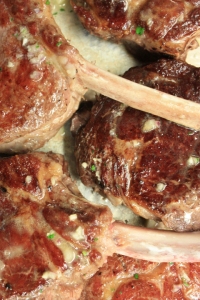Dish of the Week There's a single moment in any great meal when you hit the sweet spot and get all elements you're loving on the plate together in one perfect mouthful. Our Quail Egg Tartine was the perfect 'breakfast' moment writ large: fried egg, perfect toast, buttery tomato, salty balcony crunch. The lightly herbal and floral notes of cilantro and Rapini kept the rich umami ingredients distinct, until the last instant, when the creaminess of the egg yolk brought it all home in a Pigs & Pinot moment everyone who experienced it described as "pure bliss."
Viewing entries tagged
Sonoma County Foodshed
The Fighter: Raw Course
Chiogga Beet Tartar, Caviar Moussaline, Mustard Vinaigrette, Sunchoke Chips
 The dish we paired with The Fighter was meant to be raw and bloody ~ though the ‘blood’ came from a vibrant beet tartar whose magnificent color was spiked with a bit of vinegar. It was topped with a moussaline of whipped crème fraîche, a dollop of caviar, and a wreath of baby sunchoke chips. Texturally, while the beets and sunchoke chips initially tasted very different, the earthy flavor profiles of both root vegetables played in concert when paired with the creamy moussaline and salty caviar.
The dish we paired with The Fighter was meant to be raw and bloody ~ though the ‘blood’ came from a vibrant beet tartar whose magnificent color was spiked with a bit of vinegar. It was topped with a moussaline of whipped crème fraîche, a dollop of caviar, and a wreath of baby sunchoke chips. Texturally, while the beets and sunchoke chips initially tasted very different, the earthy flavor profiles of both root vegetables played in concert when paired with the creamy moussaline and salty caviar.
Black Swan: Salad Course Butter Lettuce Salad, Ruby Red Grapefruit, Meyer Lemon, Virgin Olive Oil, Radish
 The idea behind serving a spare green salad to honor a movie about starving ballerinas started as a joke. Then Chef saw Black Swan and was actually incredible moved by Natalie Portman’s beauty and elegance. With it’s ruffle of butter lettuce, sharp crimson edge of radish, and delicate segments of ruby red grapefruit, the salad, finished with champagne vinaigrette and a shower of flowering rapini, was indeed a visual ballet of color and form. Delicious as well.
The idea behind serving a spare green salad to honor a movie about starving ballerinas started as a joke. Then Chef saw Black Swan and was actually incredible moved by Natalie Portman’s beauty and elegance. With it’s ruffle of butter lettuce, sharp crimson edge of radish, and delicate segments of ruby red grapefruit, the salad, finished with champagne vinaigrette and a shower of flowering rapini, was indeed a visual ballet of color and form. Delicious as well.
True Grit: Fire Course Veal Chop, Boulangère Potatoes, Golden Chanterelle Mushroom, Pickled Pearl Onion
 Back in the day, when people still cooked on the hearth, small town bakeries were often used by villagers to cook their evening meal in the still warm wood fired ovens once the bread run was finished. There wasn’t a lot of heat left and space was always at a premium ~ but I’m guessing some wonderful rustic recipes came out of this unique and very communal way of cooking. The story behind Boulangère potatoes was simple: meats were put on the top shelf with sliced potatoes beneath them, the better to catch the delicious meat drippings.
Back in the day, when people still cooked on the hearth, small town bakeries were often used by villagers to cook their evening meal in the still warm wood fired ovens once the bread run was finished. There wasn’t a lot of heat left and space was always at a premium ~ but I’m guessing some wonderful rustic recipes came out of this unique and very communal way of cooking. The story behind Boulangère potatoes was simple: meats were put on the top shelf with sliced potatoes beneath them, the better to catch the delicious meat drippings.
 Ryan’s homage to the dish couldn’t involve a bread oven. But if you took your eyes away from the screen on Oscar night and closed them, it was easy to taste the inspiration. His savory layer cake of thinly shaved potatoes was saturated in dark stock that dripped down flavoring the potatoes during the baking process. Served alongside big juicy veal chops from milk and grass-fed free range calves, this was haute campfire with True Grit. The veal was sourced from Sonoma Direct, where Ritz Guggiana and his cookbook-writing daughter Marissa (Primal Cuts) find some of the most delicious ethically sustainable animals in the county.
Ryan’s homage to the dish couldn’t involve a bread oven. But if you took your eyes away from the screen on Oscar night and closed them, it was easy to taste the inspiration. His savory layer cake of thinly shaved potatoes was saturated in dark stock that dripped down flavoring the potatoes during the baking process. Served alongside big juicy veal chops from milk and grass-fed free range calves, this was haute campfire with True Grit. The veal was sourced from Sonoma Direct, where Ritz Guggiana and his cookbook-writing daughter Marissa (Primal Cuts) find some of the most delicious ethically sustainable animals in the county.
Toy Story 3: Sweet Course 3 flavors of Bon Bons
 Opps. While the Journal’s photographer clearly remembers devouring the Toy Story 3 Bon Bon course just as Best Picture was announced, images of it clearly did not make it into the camera. The plate was a riot of color ~ with sprinkles, roasted coconut and almond flakes covering dark, milk and white chocolate Bon Bons filled with passion fruit, vanilla and crème fraîche ice cream. The good news is that the Bon Bons above are equally delicious and better yet, available often on our regular dessert menu.
Opps. While the Journal’s photographer clearly remembers devouring the Toy Story 3 Bon Bon course just as Best Picture was announced, images of it clearly did not make it into the camera. The plate was a riot of color ~ with sprinkles, roasted coconut and almond flakes covering dark, milk and white chocolate Bon Bons filled with passion fruit, vanilla and crème fraîche ice cream. The good news is that the Bon Bons above are equally delicious and better yet, available often on our regular dessert menu.
(originally posted September 8, 2010)
 A few weeks back a journalist called looking for a quote for an article she was writing on the salmonella debacle, whose horrifying revelations were then just beginning to unfold. The first quotable words that came out of my mouth when she asked what I thought (lots of expletives having preceded them) were “It’s just the tip of the iceberg.” Which, sadly, it is. It’s a travesty that the simple egg, which even comes out of the animal that produces it in its own sanitary container, can be made into a lethal weapon. But that is by no means the only potentially dangerous food heading your way courtesy of a hydra-headed corporate food industry that has been built to put its own profitability before the health and safety of its customers. Up next: more meat recalls. Still, even for someone as skeptical as I am about the business practices of CAFOs (concentrated animal feeding operations), it was shocking to read that one single company alone (family owned no less) was capable of producing 2.3 million eggs a week in its Clarion, Ohio facility. We’re talking 60 million chickens folks, housed in hanger-sized industrial roosts where they lived, laid their eggs, and died inhabiting spaces the size of a shoebox. It’s not like you can take a broom and clean out a henhouse that size with the help of the neighbors.
A few weeks back a journalist called looking for a quote for an article she was writing on the salmonella debacle, whose horrifying revelations were then just beginning to unfold. The first quotable words that came out of my mouth when she asked what I thought (lots of expletives having preceded them) were “It’s just the tip of the iceberg.” Which, sadly, it is. It’s a travesty that the simple egg, which even comes out of the animal that produces it in its own sanitary container, can be made into a lethal weapon. But that is by no means the only potentially dangerous food heading your way courtesy of a hydra-headed corporate food industry that has been built to put its own profitability before the health and safety of its customers. Up next: more meat recalls. Still, even for someone as skeptical as I am about the business practices of CAFOs (concentrated animal feeding operations), it was shocking to read that one single company alone (family owned no less) was capable of producing 2.3 million eggs a week in its Clarion, Ohio facility. We’re talking 60 million chickens folks, housed in hanger-sized industrial roosts where they lived, laid their eggs, and died inhabiting spaces the size of a shoebox. It’s not like you can take a broom and clean out a henhouse that size with the help of the neighbors.
 Not these neighbors at any rate. From all available reports most of them either worked for the DeCoster family or had businesses dependent to some extent upon them. After I hung up I began to wonder at the mindset of someone living in Clarion, traveling to work every day, passing “millions of gallons of manure and putrid animal carcasses” heaped, in plain sight, beside facilities where rat excrement in the chicken feed was eventually found to be the cause of the outbreak. What were they thinking? At what point does self-interest begin to take a back seat to a greater concern for the health and safety of the community at large?
Not these neighbors at any rate. From all available reports most of them either worked for the DeCoster family or had businesses dependent to some extent upon them. After I hung up I began to wonder at the mindset of someone living in Clarion, traveling to work every day, passing “millions of gallons of manure and putrid animal carcasses” heaped, in plain sight, beside facilities where rat excrement in the chicken feed was eventually found to be the cause of the outbreak. What were they thinking? At what point does self-interest begin to take a back seat to a greater concern for the health and safety of the community at large?
It’s easy to judge the community of Clarion in hindsight, but the truth is they are not alone in turning a blind eye to the perils of modern food production. Most Americans have come to accept, even expect, cheap animal proteins in their daily diet. Instead of questioning how a plate of food that includes meat can be sourced, prepared, and served in a fast food restaurant for only $1.99, we complain when we come up against the real cost of food which has been properly farmed. A farmer I know that has a stand at the Farmers Market in Marin, an upscale town if ever there was one, told me a well dressed woman looking at her heirloom tomato prices last week ($1.50 above what we pay for them wholesale at Barndiva) told her “That’s a bit high, don’t you think? I can get six of those at Safeway for the same price.” No, actually, she can’t, not six of ‘those,’ but where is the change in having that conversation, at a Farmers Market no less?
By failing to understanding the real cost of producing food which respects the land and the animals that live on it in a manner which puts health first (their and ours, which in fact is one and the same thing) we have come to validate a false economy. One that, with the shrinking availability of the oil it's wholly dependent upon, is about to crash. The irony here is that when it does it will affect the cost of those "cheap" tomatoes a lot more profoundly than the local, seemingly more expensive ones.
 And don’t be fooled by the recent headlines that until the spigot closes, oil based agriculture will be able to help the economy in general in any meaningful way either. The lead article in the New York Times business section on September 1 may have read “strong exports lift agriculture, a bright spot in the U.S. economy,” but the key word in that seemingly optimistic headline wasn't ‘Bright’ ‘Strong’ or ‘Lift.’ It was ‘Exports.’ While the natural catastrophes in Russia, Kazakhstan and the Ukraine which decimated their wheat crops this summer, along with the increasing desperation in China to feed its exploding population have indeed lead to higher prices for wheat and grain produced by American food conglomerates, who really benefits? Read a bit further in the same article and you find out: 75% of the farm production the headline touts as being ‘on the rise’ in this otherwise dreadful economic year occurs in just 12% of the total farms in the country. If the ethically challenged DeCoster’s aren’t representative of that 12%, I’ll eat my hemp hat.
And don’t be fooled by the recent headlines that until the spigot closes, oil based agriculture will be able to help the economy in general in any meaningful way either. The lead article in the New York Times business section on September 1 may have read “strong exports lift agriculture, a bright spot in the U.S. economy,” but the key word in that seemingly optimistic headline wasn't ‘Bright’ ‘Strong’ or ‘Lift.’ It was ‘Exports.’ While the natural catastrophes in Russia, Kazakhstan and the Ukraine which decimated their wheat crops this summer, along with the increasing desperation in China to feed its exploding population have indeed lead to higher prices for wheat and grain produced by American food conglomerates, who really benefits? Read a bit further in the same article and you find out: 75% of the farm production the headline touts as being ‘on the rise’ in this otherwise dreadful economic year occurs in just 12% of the total farms in the country. If the ethically challenged DeCoster’s aren’t representative of that 12%, I’ll eat my hemp hat.
If we can just agree it’s time to understand the real costs involved in producing good safe food and adjust to the fact that it’s going to be a bit higher than we have gotten used to, where do we go from there? We can start by eating less and eating more intelligently, but obviously that alone won’t do it. We need systemic changes in the system ~ food production needs to reflect a sustainable set of values. If food producers are not held to legal standards to accomplish those, we’re doomed. Yet at precisely the moment in our history when we should be pulling together as a nation and demanding oversight and change in a unified voice that will truly serve 'the will of the people' ~ that hallowed historical tenet ~ built into the constitution to save us from ourselves when faced with precisely this kind of scenario ~ has been co-opted.
What do you really know about the Tea Party Movement? Not what you've been led to think ~ a genuine grass roots (neo-conservative) movement ~ but what do you really know about how it’s being funded and what its real agenda is?
Frank Rich wrote an eye-opening editorial two weeks ago in the New York Times in which he noted “There’s a difference between mainstream conservatism and a fringe agenda that tilts completely toward big business, whether on Wall Street or in the Gulf of Mexico, while dismantling fundamental oversight safety nets designed to protect the unemployed, public health, workplace safety, and the subsistence of the elderly.” A lot of what Rich refers to in “The Billionaires Bankrolling the Tea Party,” which we provide a link for below and urge you to read, was based on a remarkable article published last month in The New Yorker by Jane Mayer. Both articles point to overwhelming evidence that the self-serving interests driving the Tea Party Movement will subvert the very notion of grass roots that has always been relied upon to seek change from the bottom up. Instead, and possibly without the knowledge of most of its members, the TP Movement advances a singular big business agenda that cares about as much for the little guy as the DeCosters cared for their 4.6 million disease riddled chickens. Don’t get me wrong: Americans need to demand change within virtually every Federal Regulatory Agency we’ve entrusted to have our backs when it comes to labor, the environment and food safety. More and more, with every Katrina and BP disaster showing fault lines in federally funded protection agencies we should be able to depend upon, Washington begins to resemble a lawless frontier town where justice is random and graft reigns. But having a lawless town doesn’t mean you don’t need a sheriff, it means you need one whose gun fires more than blanks.
With respect to food, which this newsletter is primarily about each week, if you’re reading this within eating distance of the Sonoma County Foodshed and are tempted to think outbreaks like the Salmonella egg fiasco can’t touch you because you know where your eggs come from, think again. No matter what your individual diet is comprised of right now no matter where you source it, the dismantling of controls over food production will eventually affect all of us.
It’s one thing to be fed up with the quality of "elected representation" masquerading as leadership in Washington ~ I know I am ~ but quite another to think the center will hold in America by dismantling all our flawed but essential public programs simply because they don't serve the vested interests of powerful lobby's and the corporate entities they represent. The very way we define the words “an America of and by the people” is up for grabs, that is the real war being fought right now. As in all wars, the first thing to arm yourselves with is knowledge.
CAFO: The Tragedy of Industrial Animal Factories
With respect to The Tea Party we urge you to read Frank Rich’s editorial: The Billionaires Bankrolling the Tea Party, and the Jane Mayer article: Covert Operations, in the New Yorker.






